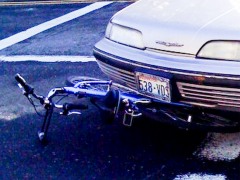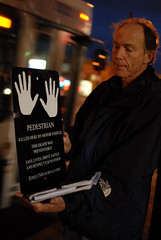
This story was written by contributing reporter Lindsay Caron. Ms. Caron took a break from working on a documentary about Canadian health insurance to focus on the issue of bicycling insurance. This is her first story for BikePortland. She has also compiled a list of existing insurance options as part of a three-part series on The Bicycle Insurance Gap.
It’s not an uncommon scenario: You’re riding down the street and are in a collision resulting in a trip to the hospital and a totaled bike. The person driving the car does not have insurance, and may suffer the legal penalty.
Either way, you are stuck with medical bills, a broken bike, time off work, and little recourse — unless you have your own car and auto insurance.

Bicycle insurance that is similar to auto insurance already exists in England, Australia, and New Zealand. It covers policyholders’ medical bills resulting from bicycle crashes, as well as covering bicycle repair or replacement and lost wages from serious injuries.
Could bike insurance serve as a safety net for the myriad of medically uninsured, car-free Portlanders?
Lawyer Ray Thomas and insurance agent Jeff Lang of Portland believe that it needs to be an option to protect people who ride here in the United States, too.
Ray Thomas is a partner at law firm Swanson, Thomas & Coon, and author of Pedal Power: A Legal Guide for Oregon Bicyclists. He also holds a Bicycle Legal Clinic several times a year to educate cyclists on their rights.
Thomas has been a major advocate of filling the void left by a lack of true bicycle insurance, and has blogged about the topic extensively.
According to the National Highway Traffic Safety Administration, 714 people were killed while bicycling in the US in 2008 and approximately 52,000 were injured, numbers that are expected to have increased in 2009. Though no statistics are available on how many of these people were insured, Thomas informs me his firm alone has seen hundreds of such cases.
For five years Thomas was involved with a team headed up by Jeff Lang, President of Gales Creek Insurance in Portland, that embarked on a quest to make this next step reality. The team sought underwriters and, in the fall of 2008, finalized an insurance plan that paralleled available auto insurance policies and included coverage for collisions involving un- or under-insured motorists. Negotiations commenced with the League of American Bicyclists (LAB) to put the plan into action.
The catch: in order for the plan to be affordable to its members yet not pose a serious financial risk to the underwriters, it would have to cover a large pool of members outside of the highest risk group — cycle-commuters with no other insurance options.
The LAB would have to include this insurance as part of their base membership fee. Even as supplemental insurance, the proposed plan was a screaming deal at only $10 a year, which would be added to the annual fee for members. Such a plan, Lang argues, could potentially make a LAB membership more attractive to new members as well as providing a basic service.
But the U.S. was on the brink of a major recession, non-profit donations were slipping, and LAB memberships were down; this was not, LAB decided, the right time to take the gamble.
The door closed on negotiations in January, 2009. Lang and Thomas have high hopes of re-opening talks during the coming year.
“Car-free people are the next step in our evolutionary progression,” says Thomas — and should have some option for protection.
See our next article in our three-part series on The Bicycle Insurance Gap: A guide to bicycle insurance options.


